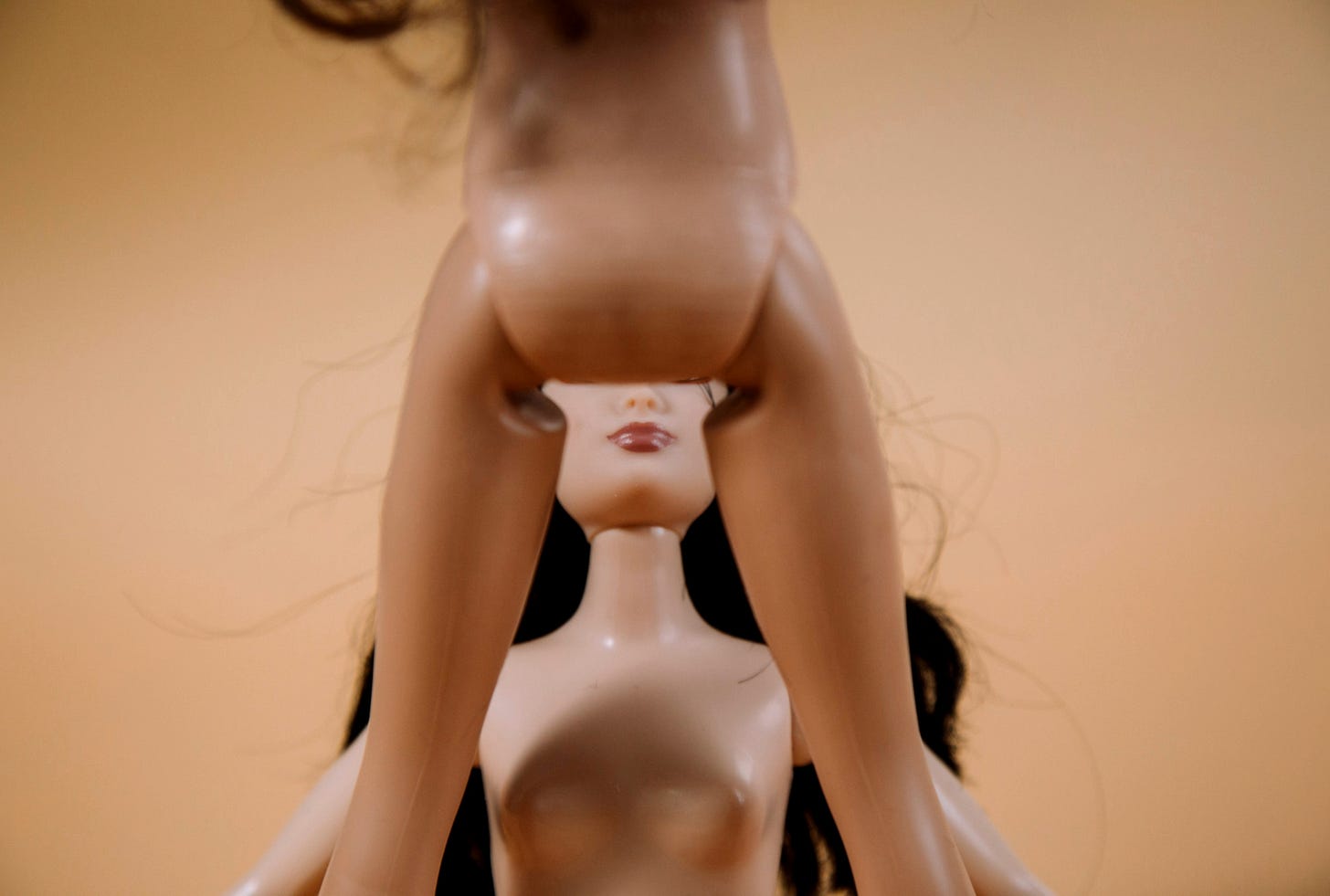
The False Promise of the ‘Barbie Vagina’ Ideal
A lack of vulva diversity in education and the media has contributed to a 250% increase in labiaplasty surgeries in the last ten years. Representation through art may be the path to healing.
Sophie Sandberg remembers standing in her bedroom, holding a mirror between her legs, trying to get a clear look at the shape of her vulva.
“It wasn’t how it was supposed to look,” she told Uncloseted Media. “And it wasn’t attractive. There were different colors. And being 14 at the time, I thought that was weird.”
While Sandberg didn’t have a clear picture of what a vulva, the external part of the female genitals often mistaken as the vagina, was supposed to look like, she knew it wasn’t what she saw in the mirror. “The image I had was more like a woman’s smooth crotch area but not the actual labia.”


Sandberg, now a 28-year-old social justice activist, is describing the so-called “Barbie Vulva,” a term coined by urogynecologist Dr. Red Alinsod in 2005.
Dr. Alinsod invented the term after he saw a rise in demands for the “Barbie Doll Vagina” procedure, where patients wanted their vulva to resemble that of a Barbie Doll’s crotch area: smooth, no hair, very flat, and most importantly, with no labia showing so only a slit remains.
Since most vulvas don’t look like this, many who desire a Barbie Vulva elect to have a labiaplasty surgery, where the labia minora, the flaps of skin on either side of the vaginal opening, are trimmed. Over the last decade, elective labiaplasty surgeries have exploded in popularity, increasing by more than 250%.

A 2023 study found that “unrealistic body standards” modeled within porn and on social media are to blame for a new generation of individuals who are getting labiaplasties to achieve the Barbie Vulva. The report surveyed 1030 individuals about their attitudes toward their genitalia. Almost a quarter of respondents between ages 18 and 24 said they felt anxious, unhappy, or embarrassed about how their labia looked, while 35% said they associated it with negative words like “weird,” “disgusting,” or “ugly.”
“The vulva is a taboo and a private part of the body,” Lynn Enright, author of the book “Vagina: A Re-Education,” told Uncloseted Media. “We don't talk about vulvas except in a sexualized way. Teenage girls especially are subjected to this.”
“When I was 14, I remember Googling the surgery,” says Kaitlyn Morris, a 24-year-old grad student in Boston. “I was just a kid, and I was like, ‘Oh, [my vulva] is not normal.’ I was super insecure. You see porn and models and they only show one type of genitalia. If you deviate from the norm, you feel bad.”
Jade Womack, who got labiaplasty surgery in 2023, says that she has been insecure about the size of her labia since she was a kid. “I've been struggling with body image problems since I was 13,” she says. “After I had my daughter, it got worse. [My labia] was very large and very long.”
Womack says that she’s “relatively happy” with the results. “One labia is still a little bit larger than the other, and there’s a little hole in one labia from the procedure, which bothers me,” she says. “So it’s not perfect, but it’s a lot better than before.”
Labiaplasty surgeries don’t come without risk. Because part of the labia is removed, unhappy patients can’t reverse poor outcomes. “People will come to me sometimes if they got it done at another place and ask, ‘Doc, can you fix it?’” says Dr. Ronald Blatt, labiaplasty surgeon at the Manhattan Center for Gynecology, adding that “about 80%” of his patients get the surgery for cosmetic reasons. “But the trim method cuts off everything. There’s nothing left to fix.”
In addition to irreversible results, labiaplasty surgeries can permanently damage nerve endings in the vulva. “I have no judgment for anybody who does their research and gets the facts of this elective surgery and what results after the scar tissue heals,” says sex educator Elizabeth Wood. “But there's a whole industry of repairs for botched surgeries.”
Wood says that people who receive the surgery can experience less pleasure from sex after recovery because plastic surgeons may not save the nerves. “Many vulva owners report numbness, lack of sensation, and inability to climax,” she says. “I want people to know how delightfully involved the labia is in sexual arousal. It is the most pleasurable center in our body, rich with 10,000 nerve endings, and we just keep losing them because of these surgeries,” she says, noting that there are only about 4,000 nerve endings in the penis.
“I would rather help support somebody to fall in love with their vulva rather than cutting it and dismissing it and potentially ruining their sex lives.”
Even without the surgery, Wood says the body image distress some have about the appearance of their vulva can make it harder to receive pleasure. According to the Genital Self-Esteem Scale, confidence in your genitals is directly related to pleasure during sex. “The more distress and discomfort you have with the appearance of your labia, the more sexual distress you have,” says Wood.
Sophie Sandberg says that her perception of her vulva changed how she had sex. “I did not enjoy people going down on me because I was worried they would look at my vagina,” she says. “It impacted my idea of myself as desirable and attractive. I still wanted to have sex with people and give them pleasure, but I had trouble receiving it for myself. There were points where I wanted to just slice it off.”
The lack of vulva diversity in the media and porn sets unrealistic expectations for men. One 2015 study found that 51% of men say the appearance of a woman’s labia influences their desire to have sex with them.
When Sandberg was in high school, a guy she hooked up with told his friends that he didn't want to sleep with her because her vagina was “ugly.”
“He said he'd rather just make out with another girl instead of having sex with me because he was not attracted to my vagina,” she says. “Shortly after that, I looked at it and was like, ‘Oh my God. It is so ugly and not how it’s supposed to look.’”
“Our language used to talk about penises and vulvas convey powerful messages,” Al Vernacchio, a high school sexuality educator in Wynnewood, Pennsylvania, told Uncloseted Media. “Our society suggests that people with penises should be proud of them and see them as signs of power and masculinity,” he says. “Societal messages about vulvas can convey negative messages about them being overly complex, mysterious, ugly, smelly, and even dangerous … Too many people, especially young people, may internalize these messages and relate to their own bodies accordingly.”
In his sex education classes, Vernacchio makes a point of showing a diverse range of bodies. “In the best case, lessons about genitals should highlight the great diversity between and among them,” he says. ‘“Different is normal’ and ‘Different does not mean better or worse’ are messages that should be highlighted.”
Lynn Enright, author of the book “Vagina: A Re-Education,” says media exposure is one of the most influential factors in women’s decisions to undergo labiaplasty. “If you don't know what vulvas look like and the vulvas you see are in mainstream porn, where the performers may have had labiaplasty or have labia that are quite symmetrical, it leaves people vulnerable to feelings of inadequacy or shame.”
Dee Hartman, a sex educator and co-founder of VulvaLove, says, “The only thing normal about a vulva is its diversity … no two labia are alike, even in one person. Just like your right and left hands are different, your labia are different sizes. Your ears are different sizes, and your eyes are shaped differently.”
In order to unravel the intense shame around vulva appearance, representation is crucial. “More representation would decrease the rate of [elective] labiaplasties and improve genital self-esteem,” Wood says, noting that most women struggle to label diagrams of vagina anatomy. “Most of the people who suffer from this shame suffer in silence because we just don't talk enough about sex.”
Sandberg felt societal pressures come undone when she started seeing more representation from The Vulva Gallery, an online social art movement. “It’s a representation of vastly different pubes, colors, labia, and normalizing all of it,” she says.
“Seeing different skin conditions or different things represented on Instagram was really helpful to know that everyone is loveable, no matter what you look like.”
“I wanted to create a body of work to show that normal doesn’t exist,” says Sam Hil Atalanta, the creator of The Vulva Gallery. The gallery aims to raise awareness around body diversity by sharing personal stories and portraits of real people’s vulvas and providing information on anatomy and sexual health. “I wanted to make sure that any person who is insecure has access to a body of work that shows diversity, and they’ll be able to find a vulva that they feel represented by.”
“We all have a role to play in building vulva pride,” says Vernacchio. “We have to consider what we think about vulvas and what we say about them. We have to counter messages that vulvas are weaker [and less worthy] than penises.”
“When you see yourself, you know you belong, and there’s so much power to that,” says Atalanta, whose Vulva Gallery has nearly 750,000 Instagram followers. “You think that ‘there are people just like me, even when I have a crooked nose, a flat butt, or a certain type of labia.’ That’s part of the diversity that is out there, and it’s gorgeous and important and reminds you not to worry.”
Sandberg, who was recently diagnosed with lichen sclerosis, a condition that causes patchy, discolored, thin skin and pain around the vulva, says that for a long time she didn’t seek a diagnosis or care because she was ashamed of how she looked. “I was so afraid of going to a gynecologist because I was worried they would say it looked weird or something,” she says. “Seeing different skin conditions of the vulva represented in the Vulva Gallery was really helpful to me. It reminds me everyone is loveable, no matter what stuff you have going on or what you look like. And it makes me grateful that I am taking care of myself now because for so long, I was ashamed of how my vulva looked.”
If objective, nonpartisan, rigorous, LGBTQ-focused journalism is important to you, please consider making a tax-deductible donation through our fiscal sponsor, Resource Impact, by clicking this button:







Republicans are banning vaginoplasties and labiaplasties for transgender women as unnecessary and only cosmetic surgery (the APA, ACS, AMA, WPATH/USPATH and Affordable Care Act all state that Gender Affirming Care is medically necessary and life saving) while at the same time coercing adult women to get the exact same surgeries so their crotches look like those of an 8 year old.
There's something deeply wrong and deeply misogynistic at the heart of American society, and whatever this malign spirit is that wants to control all female identified Americans, control all women's choices, all women's bodies, all women's very LIVES, it is right now in the driver's seat.
Remember January 21st, 2017, when 7 million American women marched (I was one of a half million in Washington DC, a half million women and only 300 portopotties) to protest the election and inauguration of a serial sexual harasser, serial adulterer, alleged child molester, known extreme misogynist, and serial rapist to the Oval Office, and another 6 million protested in sympathy worldwide, from Kiev to Kampala?
What are we doing in 2025 to PUSH BACK?!?